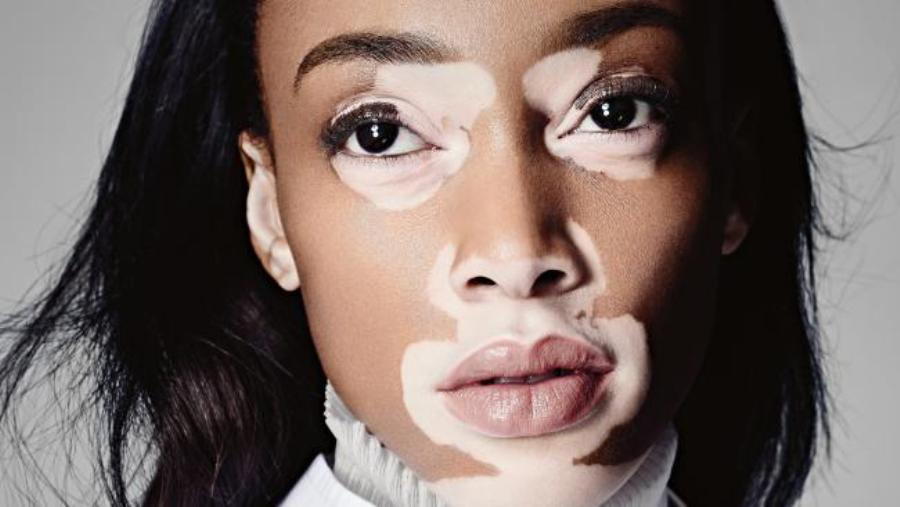Have you heard of vitiligo? I hadn’t either, before I was diagnosed with it at age 17.
I was on a beach trip when I first noticed the uneven white patches all over my body, including around my eyes; my friends joked that I looked like a raccoon. I figured it was just a weird sunburn, and for the rest of the summer, I lathered on sunscreen and tried to stay in the shade. But the white patches just spread even more, and my family took notice. Before I started college, my mom thought it would be a good idea to talk to a dermatologist.
I expected the derm to lecture me for getting a tan. Instead, I learned I have an incurable condition. “It’s called vitiligo,” the doctor told me in a cold, matter-of-fact way. With vitiligo, cells that make color in the skin (called melanocytes) are destroyed, causing white patches to appear randomly all over the body, according to the National Institutes of Health. Michael Jackson had it, and fashion model Winnie Harlow has made headlines for landing high-profile campaigns despite her spots.

Experts aren’t sure what triggers the condition (which affects about 1% of the population), but some believe it may be an autoimmune disease. With autoimmune diseases, the immune system mistakenly attacks a healthy part of your body—in this case, the melanocytes. Others theorize vitiligo may be caused by genetics, while some say emotional stress or a sunburn can trigger it.
In my case, I wouldn’t be surprised if emotional strain were the trigger, since at that time I was more stressed than I’d ever been in my life. I was in the midst of my high school graduation, my final days with a dance studio I had considered a second home for nearly 10 years, and a heart-wrenching breakup from my first serious boyfriend. Everything in my life was changing, and now my body was, too.
I was stunned by my diagnosis. Whenever I’d had a medical issue before, I could just take a pill or see another doctor to make it better. Topical creams, oral medications, UVA light treatments, and surgery may ease vitiligo symptoms, but there’s no cure. It can come back at any time, for any reason. I felt totally powerless.
I started college feeling even more stressed. To even out my skin tone, I globbed concealer on my face and slathered tanning lotions all over my body. Some of the white patches would stay put, some would get brighter, and new ones would pop up, but none of them ever went away. Doctors gave me a topical cream to put on the patches, but they said it probably wouldn’t do anything anyway. My self-confidence plummeted. I felt ugly.
My plummeting self-esteem wasn’t an unusual way to react to a vitiligo diagnosis. Even the NIH says that although the condition is neither life-threatening nor contagious, it is life-altering.
It has profound psychological and emotional implications for many patients, says Nada Elbuluk, MD, assistant professor of dermatology in the Ronald O. Perelman Department of Dermatology at NYU Langone Medical Center. “I think the psychological component of the disease is a significant one that needs attention,” she says.
For people with vitiligo, learning to cope can be very difficult—but it’s essential. For me, it took months of complaining to family and friends and feeling sorry for myself to realize I needed to make a change. I met with a therapist, who helped me uncover deeper-rooted self-esteem issues that had nothing to do with my skin, and understand it’s completely normal to blame all of your problems and insecurities on one thing.
I challenged myself to turn my focus away from my condition. I dove into my schoolwork, and decided to pursue a double major, even though I had previously been to scared to do so. I also tried harder to make friends at my school, and ended up meeting many incredible people who didn’t even notice my skin. Refocusing my energy helped build my confidence and prove to myself there was more to me than a few white spots.
One thing I had to get over was the idea that people may look at me and assume parts of my skin were pale white from a sickness or sun poisoning. That’s why Dr. Elbuluk’s believes the best way to help people with vitiligo is to increase awareness of the condition.
Many people have no idea that the condition exists, and there is very little research funding available for doctors to better understand and treat it. “Educating people can go a long way,” Dr. Elbuluk says. “If more people know that it’s a skin condition, it’s autoimmune, and it’s not contagious, that education can help take away some of the stigma that’s been associated with it.”
Today, I’ve learned to live with my white patches, and even accept them. Luckily, I haven’t had any new ones appear lately, but since this disease is so unpredictable, I could wake up tomorrow with my face covered in white splotches. Still, I’m thankful for my health, and refuse to let a skin condition affect my self-worth.
What is vitiligo?
The main symptom of vitiligo is flat, white spots or patches on your skin.
Initially, the vitiligo may start as a patch of skin that is paler than the rest.
Gradually, the patch will become completely white as the pigment in the skin begins to fade.
Vitiligo does not cause discomfort to your skin, such as dryness, but patches may occasionally be itchy.
What causes vitiligo?
Vitiligo is caused by the lack of a skin pigment called melanin.
Non-segmental vitiligo, the most common type of vitiligo, is thought to be an autoimmune condition.
This means that your immune system – the body’s natural defence system – does not work properly.
Famous sufferers of the skin condition include the model Winnie Harlow and the late singer and entertainer Michael Jackson.

